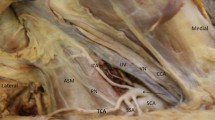Abstract
Background
Vessels in the supraclavicular area and their contribution to skin vascularization have always been studied for flaps planning in head and neck reconstruction and many pedicled flaps have been described based on those vessels. Little has been written instead about the vascularization of the supraclavicular skin itself for the use as a free flap. The purpose of this anatomical study was to assess the vascularization of the supraclavicular skin and the possibility of finding an adequate pedicle to harvest it as a free flap in order to close the donor site directly.
Methods
A total of 25 cadavers, 10 formalin fixed and 15 fresh, have been studied in cooperation with the Division for Clinical–Functional Anatomy, Department of Anatomy, Histology and Embryology, Innsbruck Medical University, Innsbruck, Austria and the Laboratoire d’Anatomie, Universiteé R. Descartes, Paris, France.
Results
The supraclavicular skin was nourished by perforators coming from the transverse cervical artery and constantly present in an average number of four. Venous drainage was accomplished through the superficial cervical vein, and not through the venae comitantes of the transverse cervical artery.
Conclusions
Based on the results of this investigation, a free supraclavicular transverse cervical artery perforator (STCAP) flap seems to be feasible pedicled on perforators from the transverse cervical artery and drained by the superficial cervical vein. Due to its thickness and skin texture, it can be indicated for facial and intraoral defects, with the limitations of a relatively short pedicle. Primary closure of the donor site can be accomplished concealing the scar in the neck crease.









Similar content being viewed by others
References
Blondeel PN, Van Landuyt KH, Monstrey SJ et al (2003) The “Gent” consensus on perforator flap terminology: preliminary definitions. Plast Reconstr Surg 112:1378–1383
Chin T, Ogawa R, Murakami M, Hyakusoku H (2005) An anatomical study and clinical cases of ‘super-thin flaps’ with transverse cervical perforator. Br J Plast Surg 58:550–555
Demergasso F, Piazza MV (1979) Trapezius myocutaneous flap in reconstructive surgery for head and neck cancer: an original technique. Am J Surg 138:533–536
Di Benedetto G, Aquinati A, Pierangeli M, Scalise A, Bertani A (2005) From the “charretera” to the supraclavicular fascial island flap: revisitation and further evolution of a controversial flap. Plast Reconstr Surg 115:70–76
Haas F, Weiglein A, Schwarzl F, Scharnagl E (2004) The lower trapezius musculocutaneous flap from pedicled to free flap: anatomical basis and clinical applications based on the dorsal scapular artery. Plast Reconstr Surg 113:1580–1590
Hartman EH, Van Damme PA, Suominen SH (2006) The use of the pedicled supraclavicular flap in noma reconstructive surgery. Plast Reconstr Surg 118:270–271
Heitland AS, Pallua N (2005) The single and double-folded supraclavicular island flap as a new therapy option in the treatment of large facial defects in noma patients. Plast Reconstr Surg 115:1591–1596
Hyakusoku H, Takizawa Y, Murakami M, Gao JH, Takekoshi A, Fumiiri M (1993) Versatility of the free or pedicled superficial cervical artery skin flaps in head and neck burns. Burns 19:168–173
Imanishi N, Nakajima H, Kishi K, Chang H, Aiso S (2005) Is the platysma flap musculocutaneous? Angiographic study of the platysma. Plast Reconstr Surg 115:1018–1024
Lamberty BG (1979) The supra-clavicular axial patterned flap. Br J Plast Surg 32:207–212
Mathes S, Vasconez L (1978) The cervico-humeral flap. Plast Reconstr Surg 61:7–12
Mizerny BR, Lessard ML, Black MJ (1995) Transverse cervical artery fasciocutaneous free flap for head and neck reconstruction: initial anatomic and dye studies. Otolaryngol Head Neck Surg 113:564–568
Morris RL, Dillman D, McCabe JS, Holdredge T, Carson L, Given KS (1983) The transverse cervical neurovascular free flap. Ann Plast Surg 10:90–98
Mutter T (1842) Case of deformity from burns relieved by operation. Am J Med Sci 4:66
Ogawa R, Murakami M, Vinh VQ, Hyakusoku H (2006) Clinical and anatomical study of superficial cervical artery flaps: retrospective study of reconstructions with 41 flaps and the feasibility of harvesting them as perforator flaps. Plast Reconstr Surg 118:95–101
Pallua N, Machens HG, Rennekampff O, Becker M, Berger A (1997) The fasciocutaneous supraclavicular artery island flap for releasing postburn mentosternal contractures. Plast Reconstr Surg 99:1878–1884 Discussion 1885–1876
Pallua N, Magnus Noah E (2000) The tunneled supraclavicular island flap: an optimized technique for head and neck reconstruction. Plast Reconstr Surg 105:842–851 Discussion 852–844
Rashid M, Zia-ul-Islam M, Sarwar SR, Bhatti AM (2006) The “expansile” supraclavicular artery flap for release of post-burn neck contractures. Br J Plast Surg 59:1094–1101
Shiozaki K, Abe S, Agematsu H, Mitarashi S, Sakiyama K, Hashimoto M, Ide Y (2007) Anatomical study of accessory nerve innervation relating to functional neck dissection. J Oral Maxillofac Surg 65:22–29
Testut L, Latarjet A (1972) Trattato di Anatomia Umana, vol 2. Unione Tipografico-Editrice Torinese. Torino, p 767)
Vinh VQ, Ogawa R, Anh TV, Hyakusoku H (2007) Reconstruction of neck scar contractures using supraclavicular flaps: retrospective stud of 30 cases. Plast Reconstr Surg 119:130–135
Weiglein AH, Moriggl B, Schalk C, Kunzel KH, Muller U (2005) Arteries in the posterior cervical triangle in man. Clin Anat 18:553–557
Yu P (2005) The transverse cervical vessels as recipient vessels for previously treated head and neck cancer patients. Plast Reconstr Surg 115:1253
Author information
Authors and Affiliations
Corresponding author
Rights and permissions
About this article
Cite this article
Cordova, A., D’Arpa, S., Pirrello, R. et al. Anatomic study on the transverse cervical vessels perforators in the lateral triangle of the neck and harvest of a new flap: the free supraclavicular transverse cervical artery perforator flap. Surg Radiol Anat 31, 93–100 (2009). https://doi.org/10.1007/s00276-008-0410-x
Received:
Accepted:
Published:
Issue Date:
DOI: https://doi.org/10.1007/s00276-008-0410-x




